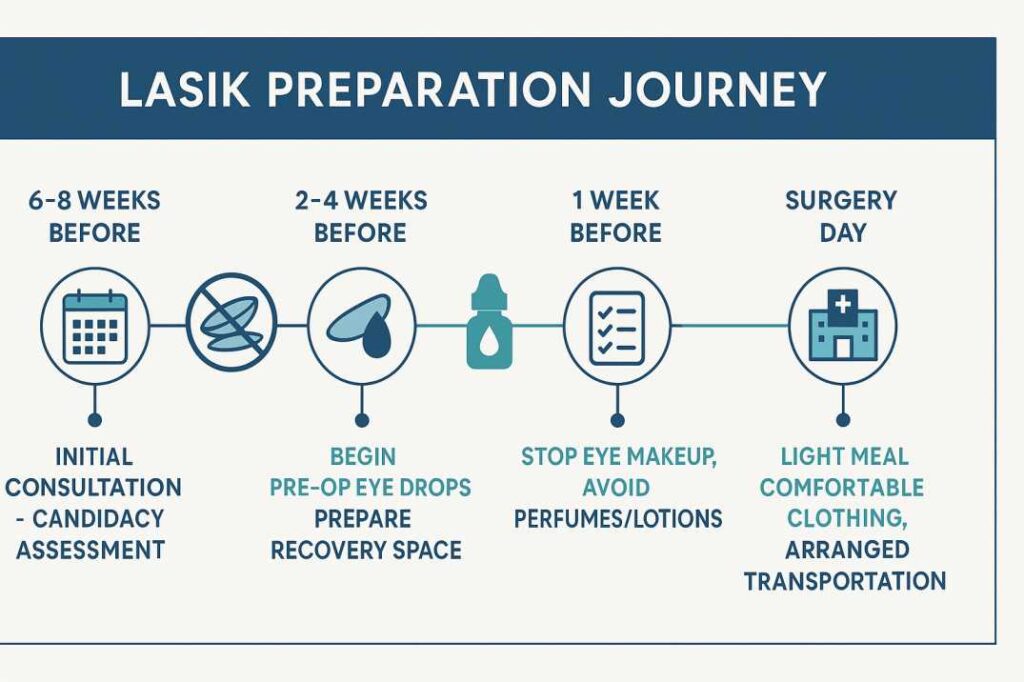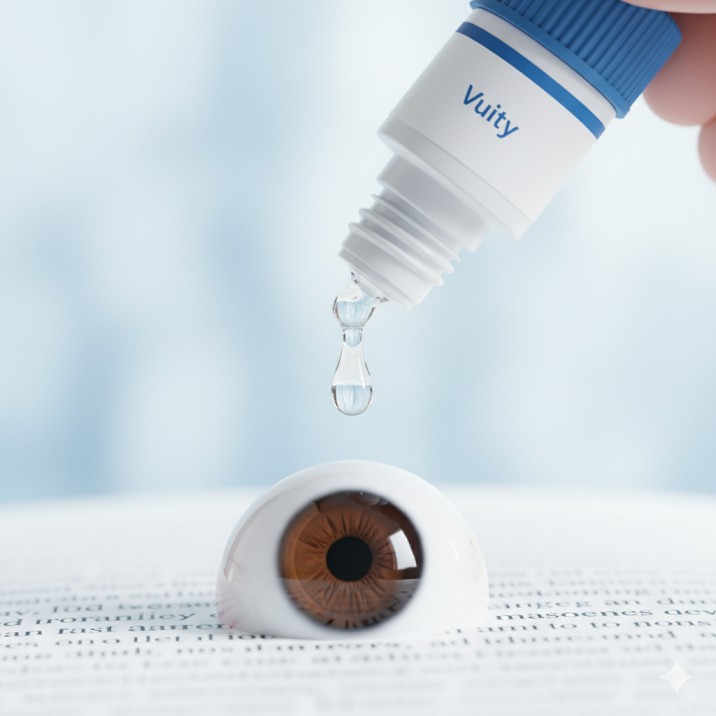Preparing for LASIK: Your Complete Pre-Surgery Guide
If you’re considering LASIK eye surgery, you’re joining millions who have already transformed their vision and their lives. With patient satisfaction rates of 96% and 99% of patients achieving 20/40 vision or better (with over 90% reaching 20/20 vision), LASIK has become the gold standard for vision correction. However, proper preparation is essential to achieving optimal results and ensuring a smooth recovery.
This comprehensive guide will walk you through everything you need to know before your LASIK procedure, from initial consultation to surgery day preparations, helping you approach your vision correction journey with confidence and peace of mind.
Understanding LASIK: What to Expect
LASIK (Laser-Assisted In Situ Keratomileusis) is a proven surgical procedure that reshapes the cornea to correct nearsightedness, farsightedness, and astigmatism. During the procedure, your surgeon creates a thin corneal flap and uses a precision laser to reshape the underlying tissue, allowing light to focus correctly on your retina.
The actual laser treatment takes less than one minute per eye, with the entire procedure typically completed in under 30 minutes. Most patients achieve 20/40 vision or better, with over 90% reaching 20/20 vision. What makes LASIK particularly appealing is its quick recovery time—many patients notice improved vision within hours and can return to most normal activities within 24-48 hours.
Initial Consultation and Candidacy Assessment
Choosing the Right Surgeon
Your LASIK journey begins with selecting an experienced, qualified surgeon. Look for an ophthalmologist with:
- Extensive experience performing LASIK procedures (thousands of surgeries)
- Board certification in ophthalmology
- Access to the latest laser technology and diagnostic equipment
- Positive patient reviews and testimonials
- A willingness to discuss all your questions and concerns
During your consultation, a reputable surgeon will thoroughly evaluate whether you’re a good candidate for LASIK rather than simply promoting the procedure to everyone who walks through the door. Be wary of clinics that claim everyone qualifies for LASIK or offer prices that seem too good to be true—your vision deserves the highest standard of care.
Pre-Operative Evaluation
Your initial consultation includes a comprehensive eye examination to determine your candidacy. Your surgeon will assess:
Eye Health Factors:
- Corneal thickness and shape (using advanced topography mapping)
- Pupil size, especially in dim lighting
- Tear film quality and dry eye symptoms
- Eye pressure (to rule out glaucoma)
- Overall eye health (checking for infections, inflammation, or other conditions)
Medical History Considerations:
- Age (typically best for patients 25-40, though older patients may qualify)
- Prescription stability (your prescription should be stable for at least one year)
- Current medications and allergies
- Autoimmune conditions or immune system disorders
- Eye diseases like keratoconus, cataracts, or severe dry eye
- Pregnancy or breastfeeding status (hormonal changes affect vision)
Be completely honest and thorough when discussing your medical history. Your surgeon can only make the best recommendations based on the information you provide. Don’t downplay symptoms or omit details—share everything that might be relevant to your eye health and overall wellbeing.
Understanding Costs and Insurance
LASIK is typically considered an elective procedure, meaning most insurance plans won’t cover the costs. According to the most recent Market Scope survey, LASIK costs in the United States typically range from $1,500 to $5,000 per eye, with a national average of approximately $2,000 to $3,000 per eye depending on provider, location, technology used, and the complexity of your prescription. However, many practices offer:
- Financing options with payment plans
- Health Savings Account (HSA) or Flexible Spending Account (FSA) payment options
- Bundled pricing that includes pre-operative exams, surgery, and follow-up care
- Enhancement guarantees if additional correction is needed
During your consultation, request a detailed, itemized quote that includes all costs: the procedure itself, pre-operative testing, medications, and post-operative visits. Ask about enhancement policies—what happens if you need additional correction later? Understanding the full financial picture upfront prevents surprises and helps you budget appropriately.
Critical Pre-Surgery Timeline: What to Stop (and When)
Contact Lens Discontinuation
One of the most important pre-surgery steps is discontinuing contact lens wear well before your procedure. Contact lenses can temporarily alter your cornea’s shape, potentially affecting the accuracy of your pre-operative measurements and surgical planning.
Recommended discontinuation periods:
- Soft daily wear contact lenses: 5-7 days before evaluation and surgery
- Soft extended-wear contact lenses: 2 weeks before evaluation and surgery
- Toric lenses (for astigmatism): 10-14 days before evaluation and surgery
- Rigid gas permeable (RGP) lenses: 4 weeks before evaluation and surgery
- Hard contact lenses: 6-12 weeks before evaluation and surgery
Your surgeon will provide specific instructions based on your lens type and how long you’ve been wearing contacts. Follow these guidelines precisely—your cornea needs time to return to its natural shape for accurate measurements. Switch to wearing glasses full-time during this period, even if it feels inconvenient.
Medications and Supplements
Discuss all medications and supplements with your surgeon during your consultation. Some may need to be adjusted or temporarily discontinued:
Generally safe to continue:
- Most prescription medications (with your doctor’s approval)
- Daily vitamins and minerals
May need to be modified:
- Allergy eye drops (often stopped on surgery day, resumed the next day)
- Certain dry eye medications (your surgeon may prescribe specific pre-operative eye drops instead)
- Blood thinners (discuss with both your LASIK surgeon and prescribing physician)
Important for dry eye management: Your surgeon may prescribe prescription eye drops like Restasis to improve tear production beginning several weeks before surgery. Healthy tear film is crucial for optimal healing and comfort after LASIK.
The Week Before Surgery: Essential Preparations
Lifestyle Modifications
Hydration: Your body is approximately 60% water, and proper hydration supports every cell, tissue, and organ. Well-hydrated eyes are less prone to dryness after LASIK and heal more efficiently. Aim for at least eight 8-ounce glasses of water daily in the week leading up to your surgery.
Avoid Alcohol and Tobacco: Both alcohol and tobacco can negatively impact your body’s healing capabilities. Alcohol is also dehydrating, which can worsen dry eye symptoms. Stop drinking alcohol at least 24 hours before surgery, and avoid tobacco products for at least two weeks before and after your procedure to promote optimal healing.
No Eye Makeup: Stop wearing eye makeup (mascara, eyeliner, eyeshadow) at least 48 hours before surgery. Makeup debris and residue along your eyelashes can increase infection risk. Some surgeons recommend gently scrubbing your eyelashes daily for several days before surgery to remove any buildup.
Practical Preparations
Arrange Transportation: You cannot drive yourself to or from your LASIK appointment. The pre-operative sedative medication will affect your ability to drive, and your vision will be blurry immediately after surgery. Arrange for a reliable friend or family member to drive you to your procedure and your first follow-up appointment.
Prepare Your Recovery Space: Set up a comfortable, quiet area for rest after surgery. Stock up on:
- Preservative-free artificial tears (your surgeon will recommend specific brands)
- Prescription eye drops (pick these up before surgery day)
- Over-the-counter pain medication like acetaminophen (Tylenol)
- Tissues (eyes may water frequently at first)
- Polarized sunglasses for light sensitivity
- Audiobooks, podcasts, or music (avoid screen time initially)
Prepare Meals and Complete Chores: Handle any household tasks, laundry, and meal preparation before your surgery. Prepare easy-to-reheat meals so you won’t need to cook during your first few days of recovery. This foresight allows you to focus entirely on resting and healing.
Surgery Day: What to Expect and How to Prepare
Morning Routine
Cleanliness is Critical:
- Shower and wash your hair thoroughly (avoid getting soap directly in your eyes)
- Wash your face with a gentle cleanser, removing all traces of makeup, creams, and lotions
- Clean your eyelashes and eyelids carefully
- Do NOT apply any facial products: no moisturizer, sunscreen, makeup, perfume, cologne, aftershave, hair gel, or hairspray.
These products can interfere with the sterile surgical environment and potentially cause complications. The air quality in the laser suite is tightly controlled, and fragrances can disrupt the carefully regulated temperature, humidity, and purity.
Dress Comfortably:
- Wear loose, comfortable clothing (the surgery room is kept cool for laser equipment)
- Avoid fuzzy or lint-producing fabric.s
- Skip accessories, jewelry, and hair ties that might interfere with head positioning.
- Women should avoid ponytails or clips that prevent resting comfortably on their backs
Eat Lightly: Unlike many surgical procedures, you don’t need to fast before LASIK. In fact, having a light meal or snack is recommended since you’ll be given sedative medication. Avoid caffeine and sugary foods that might make it difficult to relax or rest after the procedure.
At the Surgery Center
Plan to spend approximately 2 hours at the surgery center, though the actual procedure takes less than 30 minutes. This time allows for:
- Completing any final paperwork and informed consent forms
- Pre-operative medication administration (mild sedative to reduce anxiety)
- Eye area cleaning and antiseptic application
- Numbing eye drops application
You’ll then enter the laser suite and recline on a comfortable surgical bed. Your surgeon will use a small device called a lid speculum to gently hold your eyelids open—this doesn’t hurt but may feel unusual. Numbing drops ensure you won’t feel pain, though you might experience slight pressure sensations.
During the procedure, you’ll be asked to focus on a target light. Advanced laser tracking systems follow your eye movements, so don’t worry about staying perfectly still. The laser makes clicking sounds as it works, and you might notice a faint odor—this is normal and nothing to be concerned about.
Immediately After LASIK: First Hours and Days
The First 24 Hours
Right after surgery, your eyes may feel:
- Gritty or sandy
- Watery or teary
- Itchy (resist the urge to rub!)
- Light-sensitive and slightly uncomfortable
Your vision will be blurry at first, improving gradually over the following hours and days. Go directly home and take a 4-6 hour nap—this is crucial. Sleep allows your body to enter healing mode, helping the corneal flap settle properly.
Critical Post-Operative Rules:
- Wear your protective eye shields while sleeping for the first week
- Do NOT rub your eyes for at least one month
- Use prescribed eye drops exactly as directed
- Keep your eyes closed during the drive home
- Avoid screens, reading, and bright lights for the first day
Medication Schedule
Follow your prescribed eye drop regimen precisely:
Antibiotic drops (e.g., Vigamox, Zymar):
- Frequency: Typically 4 times daily for one week
- Purpose: Prevent infection during healing
Anti-inflammatory drops (e.g., Pred Forte, Durezol):
- Frequency: As prescribed (often 4 times daily initially, then tapering)
- Purpose: Reduce inflammation and promote healing
Preservative-free artificial tears:
- Frequency: Every 1-2 hours while awake for the first week, then as needed
- Purpose: Keep eyes moist and comfortable
Some drops may cause mild stinging, and you might notice crusting around your lashes when you wake up. If this occurs, place a warm, damp washcloth over your eyes for 5 minutes, then gently brush away the residue.
What to Avoid After LASIK
First Week
- Eye makeup, creams, lotions, and perfumes
- Rubbing or touching your eyes
- Swimming pools, hot tubs, and whirlpools
- Vigorous exercise or activities that cause sweating
- Dusty or smoky environments
- Getting soap or water directly in your eyes (sponge baths are fine)
First Month
- Contact sports or activities with risk of eye injury (boxing, football, martial arts)
- Excessive screen time (take frequent breaks and use artificial tears)
Recovery Timeline Expectations
Within 24 hours: Most patients can drive and return to desk work. 3-5 days: Vision continues improving; can resume light exercise. 1 week: Can resume wearing eye makeup (with new, clean products). 2-4 weeks: Can resume swimming and vigorous exercise. 1-3 months: Vision may continue stabilizing. 3-6 months: Final vision stabilization.
Some patients experience glare, halos around lights, or difficulty with night driving during the first few months. These symptoms typically diminish as the eyes heal completely.
Follow-Up Care and Long-Term Success
Post-Operative Appointments
Your first follow-up appointment typically occurs 24-48 hours after surgery. Your surgeon will:
- Check healing progress
- Measure visual acuity
- Examine the corneal flap
- Address any concerns or questions
- Adjust medication schedules if needed
Additional follow-up visits usually occur at one week, one month, three months, and six months. Attend all scheduled appointments—they’re essential for monitoring your healing and ensuring optimal results.
Managing Dry Eye
Dry eye is the most common temporary side effect after LASIK, affecting approximately 28-30% of patients initially, though most cases improve significantly within 3-6 months as nerves regenerate and tear production normalizes. Your surgeon may recommend:
- Continued use of preservative-free artificial tears
- Omega-3 fatty acid supplements
- Warm compresses and eyelid hygiene
- Prescribe dry eye medications if needed
- Punctal plugs (tiny devices that block tear drainage) in persistent cases
When to Contact Your Surgeon
Call your surgeon immediately if you experience:
- Severe pain not relieved by over-the-counter medication
- Sudden vision loss or significant vision changes
- Signs of infection (increased redness, discharge, swelling)
- The sensation that something is stuck in your eye that doesn’t improve
- Flashing lights or new floaters
Most LASIK patients experience straightforward, complication-free recovery. However, staying vigilant and promptly addressing concerns ensures any issues are caught and managed early.
Setting Realistic Expectations
While LASIK boasts exceptional success rates, understanding realistic outcomes helps ensure satisfaction:
Vision Results:
- 99% of patients achieve 20/40 vision or better
- 90% achieve 20/20 vision or better
- Some patients achieve vision better than 20/20 (such as 20/15)
- Not everyone achieves perfect vision without glasses
Enhancement Procedures:
- 1-2% of patients need enhancement within the first year
- 3-5% may need enhancement over many years as prescriptions naturally change
- Enhancements can often improve distance vision further
- However, enhancements typically won’t eliminate glare or halos if present
Presbyopia Considerations: If you’re over 40, understand that LASIK corrects distance vision but doesn’t prevent age-related near vision changes (presbyopia). You may eventually need reading glasses, though many patients find this a worthwhile trade-off for clear distance vision.
Recent Research Supporting LASIK Safety and Effectiveness
Study 1: Long-Term Safety and Patient Satisfaction
A comprehensive review published in the Journal of Cataract & Refractive Surgery examined nearly 68,000 LASIK procedures and found patient satisfaction rates of 96%. The study confirmed that serious complications remain under 1%, with most side effects being temporary and resolving within 3-6 months. Since FDA approval in the 1990s, an estimated 20 to 25 million laser vision correction procedures have been performed in the United States, with approximately 700,000 to 800,000 procedures performed annually in recent years. This research reinforces LASIK’s position as one of the safest and most successful elective procedures available today.
Study 2: Twelve-Year Follow-Up Study
Published in BioMed Research International, a 12-year longitudinal study tracked patients who underwent LASIK for moderate to high myopia. The research found that 92% of eyes remained within ±2.0 diopters of intended correction after a decade, demonstrating exceptional long-term stability. Serious late complications like corneal ectasia were extremely rare, particularly when proper screening protocols excluded high-risk patients.
Study 3: FDA Patient-Reported Outcomes Study
The FDA’s Patient-Reported Outcomes with LASIK (PROWL) study analyzed real-world patient experiences and found remarkable results: only 0.44% of participants (1 out of 574) reported losing two or more lines of vision. This comprehensive research confirmed that when patients are properly screened and surgeons follow established protocols, LASIK delivers consistently excellent outcomes with minimal risks.
References and Resources
The information in this guide is based on current medical research and authoritative sources. Below are key resources that informed this article:
1. U.S. Food and Drug Administration (FDA) – LASIK Information
Source: FDA Center for Devices and Radiological Health
URL: https://www.fda.gov/medical-devices/lasik/
Key Information: Comprehensive LASIK guidelines including patient screening criteria, contact lens discontinuation requirements, informed consent processes, and the FDA’s Patient-Reported Outcomes with LASIK (PROWL) studies. The FDA PROWL research found that only 0.44% of participants (1 out of 574 patients) reported losing two or more lines of vision, demonstrating LASIK’s exceptional safety profile.
2. Journal of Cataract & Refractive Surgery – LASIK Outcomes Meta-Analysis
Source: Sandoval et al., “Modern Laser in Situ Keratomileusis Outcomes”
Citation: Journal of Cataract & Refractive Surgery, Vol. 42, Issue 8, August 2016, Pages 1224-1234
Key Information: This comprehensive meta-analysis examined nearly 68,000 LASIK procedures and found patient satisfaction rates of 96%, with 99% of patients achieving 20/40 vision or better and more than 90% achieving 20/20 vision or better. The study confirmed serious complication rates remain under 1%, establishing LASIK as one of the safest elective procedures available.
3. BioMed Research International – Twelve-Year LASIK Follow-Up Study
Source: Ikeda et al., “Twelve-Year Follow-Up of Laser In Situ Keratomileusis for Moderate to High Myopia”
Citation: BioMed Research International, 2017, Article ID 9304513
URL: https://doi.org/10.1155/2017/9304513
Key Information: This longitudinal study tracked 68 eyes over 12 years and found that 92% remained within ±2.0 diopters of the intended correction after a decade, demonstrating exceptional long-term stability. The research showed that LASIK results remain largely stable over time, with serious late complications like corneal ectasia being extremely rare when proper screening protocols are followed.
These sources represent gold-standard research and regulatory guidance in the field of refractive surgery. For additional information about LASIK candidacy, costs, and what to expect, consult with a board-certified ophthalmologist who specializes in refractive surgery.
Final Thoughts: Your Path to Clear Vision
Preparing for LASIK doesn’t have to feel overwhelming. By following your surgeon’s instructions, asking questions when you’re unsure, and taking care of yourself before and after the procedure, you’re setting yourself up for the best possible outcome.
Remember that LASIK is a partnership between you and your surgical team. Your surgeon brings expertise, precision technology, and years of experience. You contribute by being honest about your health history, following pre- and post-operative instructions carefully, and attending all follow-up appointments.
For many people, LASIK is genuinely life-changing—imagine waking up and seeing the alarm clock clearly, swimming without worrying about contacts, or simply enjoying the freedom of clear vision without glasses. With proper preparation and realistic expectations, you can join the millions who’ve successfully transformed their vision through LASIK.
Take your time making this decision. Research your surgeon thoroughly, ask all your questions during the consultation, and trust your instincts. When you’re ready, approach your LASIK journey with confidence, knowing you’ve prepared yourself well for this exciting step toward clearer vision.
FAQs
-
-
Stop wearing contact lenses, keep your eyes clean, stay hydrated, and follow all pre-op instructions from your surgeon.
-




